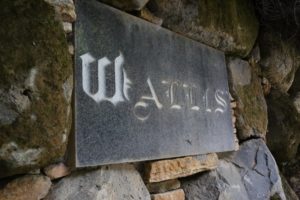
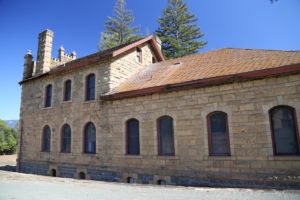 Wallis Estate is located in the hills of the Diamond Mountain AVA. Founder Edward J. Wallis (named after his grandfather) grew up in the San Francisco Bay Area and moved to Napa Valley soon after college. He purchased this property in 1975 (85 acres) and raised his family here. He remembers the valley being a sleepy place at the time – with only a few wineries producing commercially compared to the hundreds today. However, he did not catch the wine bug early on, rather he built his career in the real estate world.
Wallis Estate is located in the hills of the Diamond Mountain AVA. Founder Edward J. Wallis (named after his grandfather) grew up in the San Francisco Bay Area and moved to Napa Valley soon after college. He purchased this property in 1975 (85 acres) and raised his family here. He remembers the valley being a sleepy place at the time – with only a few wineries producing commercially compared to the hundreds today. However, he did not catch the wine bug early on, rather he built his career in the real estate world.
One of his projects was local, a housing development with several small parks on Mitchell Drive in St. Helena. One of the parks, a one-acre parcel was originally referred to as Wallis Park for several years until it was renamed to Mary Elizabeth Fryer Park in 1994. Fryer was the chairman of the St. Helena Planning Commission from 1978 to 1994 (she died in 2021). Edward and his wife Marilyn donated a plaque (also listing Edward’s mother Ann Milton Wallis) located at the entrance to the park indicating their gift of this land to the community.
In 1997 Edward planted vineyards with the sole intent to sell the grapes. And he did, to a number of premium producers including Duckhorn, Lokoya and Ramey Wine Cellars. Upon tasting some of the wines that were being made with his fruit and seeing the well-regarded reviews being given by wine writers he decided to make his own wine and the first Wallis Estate wine was from the 2006 vintage.
Plans for the property continue to evolve – the vineyards they had been using for each vintage was sold to Jackson Family Estates in 2014; several more acres more planted in a different part of the property. Despite selling the vineyard portion, the fruit from this vineyard continues to be sold to Wallis Estate so they continued to make wine from the same vines prior to their new vineyard coming into production.
The thirteen acres of vines are divided into eight unique blocks predominately of Cabernet Sauvignon, Petit Verdot and Cabernet Franc. Each year two wines are made; a wine predominately Cabernet Sauvignon with small blends of other varietals called the “little sister” and their primary wine, a 100% Cabernet Sauvignon. The exception year to the two wines was 2011 – a challenging year where they just did not have enough fruit for both wines and only the “little sister” was made.
Mary Elizabeth Fryer Park, St. Helena
The location has certainly proved itself from a vineyard standpoint; Diamond Creek Vineyards are their immediate neighbor with both properties touching each other. Nearby wineries also included the former Von Strasser and Reverie.
Classic Diamond Mountain land is steep, rugged, brushy, rocky, and east facing. This property has some gentle slopes but is surrounded by steep hillsides, especially to the east. Historical photos of the Wallis Estate property showed much of the surrounding hillside land clear cut when trees were harvested in the area. The Mayacamas mountain range in this region, of which the Diamond Mountain appellation is part of, is similar to California’s Sierra Nevada mountains on a much smaller scale in that the western side of the range has a gentler elevation gain while the eastern side drops off rather dramatically. You can experience this on any of the steep narrow roads that climb out of the Napa Valley floor crossing over the Mayacamas mountains. Flat land is at a premium here.
The entire appellation is over 400 feet; the Wallis Estate vineyards range from 600 to 800 feet. Because of its northern location and elevation most of the appellation is above the fog line. The soils are porous and volcanic in nature, often containing black glass (obsidian). The first vines (Cabernet Sauvignon) were planted in this region in the early 1860s by wine pioneer Jacob Schram, the founder of Schramsberg Vineyards, currently owned by the Davies family. The upper most border of the appellation reaches the ridge line of the Mayacamas mountains and the Sonoma County line but does not cross over. And while we have not verified this stat, we heard that Diamond Mountain has the highest percentage of Cabernet Sauvignon of its total planted acreage compared to any other sub appellation in Napa Valley.
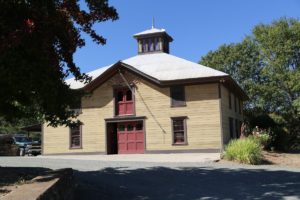
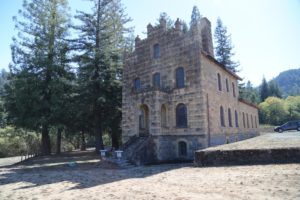 This property was purchased in 1905 by French born Jacques Pacheteau, who perhaps was attracted to it’s views and cold, clear natural springs. Along with several other vineyard properties in the AVA, this property is also historic with the two primary buildings on site listed in the Napa County Landmarks preservation society (as of 2015). The wooden carriage house was built sometime in the late 1800s and was used to house wagons; today it is beautifully restored. Pacheteau also built a stone “castle” which was known as Chateau Pacheteau. It looks like an old “ghost” winery, however, it was never used as a winery.
This property was purchased in 1905 by French born Jacques Pacheteau, who perhaps was attracted to it’s views and cold, clear natural springs. Along with several other vineyard properties in the AVA, this property is also historic with the two primary buildings on site listed in the Napa County Landmarks preservation society (as of 2015). The wooden carriage house was built sometime in the late 1800s and was used to house wagons; today it is beautifully restored. Pacheteau also built a stone “castle” which was known as Chateau Pacheteau. It looks like an old “ghost” winery, however, it was never used as a winery.
Poor Mr. Pacheteau in 1905 was the subject of one the craziest and strangest attacks in the history of Napa Valley. An article in the Napa Journal dated December 8, 1905 details what happens exceptionally well. We will briefly summarize. One of Pachetau’s employees showed up at 1130pm one night at the house where he and his niece were living at the time. For reference, Pachetau wasn’t married at the time and was in between wives. The deranged assailant entered the house, then removed all his clothes and entered the nieces room. He tried to attack her but she started screaming and so the assailant went into the next room and attacked Pacheteau who was still in bed but was wakened by the screaming. He stabbed him in the breast deeply with a ‘long knife’ – the force of the stabbing breaking the knife handle. Because the knife then slipped from his hand, the article suggests that Mr. Pachetau’s life was probably saved.
The crazy then fled the house and ran 3/4 of a mile to his own cabin, presumably completely naked since he left the Pachetau household in an extreme hurry. Reaching the cabin which he shared with three other workers, he immediately grabbed his shotgun, loaded two shells and attempted to blow off his own head. The article states, “The man’s aim was not good however, and both shots missed his head”. Failing with the shotgun, he then picked up a razor and slashed his own throat multiple times, in the process completely severing his own windpipe, and if that wasn’t enough, he sliced open his own abdomen. The deranged eventually fell to the floor, his roomies called for help and he was taken by train on stretcher to the county hospital in Napa for medical treatment. Fortunately Pachetau recovered from his own wound. A follow up article a day later mentioned a constable suggesting that the assailant was, “probably somewhat under the influence of liquor”. All we can say to that is that must have been some seriously f#@$#ed up liquor.
An article in The St. Helena Star dated March 9, 1906 details the beginning of the construction of Chateau Pacheteau that year. “It will be two stories in height and when completed will present a massive and imposing presence”. The article also mentioned that a W.A. Harrison of St. Helena was the carpenter of record and Bennasini & Maggetta were the stone masons. And a reference was made about, “a large force of men preparing the land for grapevines”. The ‘castle’ was completed in 1909. Incidentally, 1906 was the same year that Larkmead Cellars began construction of their new cellar.
The May 28, 1915 edition of The St. Helena Star contains an article about the property including mentioning earlier work, that after the woods and brush were cleared away, vineyards and orchards were planted and gardens established. The article also states, “Orange trees bear luscious fruit, sweet and juicer than the best in the sunny south, while the soil produces such vegetables as one is rarely privileged to see”.
Walking inside today is a historical glimpse into a time period over 100 years old; the inside is wonderfully furnished and even the original iron stove remains in the kitchen and still functions. Pacheteau was originally from France – settled in New York for a while and became a wine merchant before moving to Napa Valley. His business was built on purchasing barrels of California wine and selling them at a higher price in New York. His first shipment according to his obituary in several local newspapers, was 400 barrels. Despite living in Napa Valley, he kept his New York business connections and regularly sent wine back east.
Vines were first planted on the property during the construction of the stone building and the carriage house and were tended to until the start of Prohibition in 1919. Jacques was called that same year while on a business trip in New York, and his widow and second wife Georgiana took over the ownership until she was summoned in 1959. The Pacheteau’s son Jacques (Jack) was living in the home at the time of her death. The title of the property was transferred to the Bank of America National Trust and Savings in 1961. This entity sold the property to Edward Wallis.
Nearby Pachateau Road (note the slightly different spelling in comparison to their last name) is a reminder of their time here, a side road road off of Diamond Mountain Road. We have seen references to Diamond Mountain Road previously referred to as the, ‘Road of the 13 Bridges’.But much more important than an homage on a road sign, were their contributions to the community of Calistoga. The couple established Pacheteau’s Hot Spring, also called Pacheteau Baths, in 1919 with the purchase of 110 acres from Stanford University (shortly before Jacques’ death). What was Pacheteau’s Hot Spring is now a part of Indian Springs Resort. According to Indian Springs Resort, Leland Stanford purchased this land in 1880 with the intent of building Stanford University here. That obviously never happened. In 1919 a new bath house was built at the mud baths in a Mission style with white stucco walls. Total cost of the structure was $25,000. Georgiana continued to develop and operate the resort for more than three decades.
Pacheteau Baths were well advertised, especially with ads that ran in San Francisco Bay Area newspapers. We have also seen mention in other newspapers in the 1920s and 1930s outside of California including an article in the Sioux City Journal dated December 10, 1922 which described, the famous Pachetau baths as, “where society women daily can be seen, stepping out of their cars, disrobing and rolling in mire”. The baths employed both masseurs and a masseuses and a medical doctor. And a riding stable was also located on the property.
An article in The St. Helena Star dated January 20, 1928 describes a new well that Georgiana had drilled on her property as part of a number of improvements she was making to the resort that year. The well reached 150 feet below the surface and then became a geyser (described by the author as a real dandy) spewing boiling water into the air up to an elevation of 150 feet. The author of the article had a real way with words and mentioned, “The geyser is flooding the land in its vicinity with water, but although many offer suggestions as to how to curb the unruly spouter, like some human spouters, it will not be curbed”. The Calistoga Fire Department was called onto the scene but fortunately workers were finally able to pour cold water onto the geyser to cool it enough that it could be capped without anyone getting burned.
It wasn’t always a bed of rose petals operating the hot springs; one time a women sued because she was attacked by a dog on the property and several times, suits were filed over burn damages including one by a main who claimed second degree burns on his abdomen while trying to enjoy one of the mud baths, leaving large and disfiguring scars. The suits progressively were filed for higher damage amounts including one in 1953 from a lady who suffered multiple fractures of the hip when a railing broke against her weight in a shower stall causing her to fall to the ground.
Select Wines
The 2010 Wallis Estate “little sister” is dark garnet in the glass with black fruit aromas including currant, blackberry and dark cherry. Given time to breath, this wine shows a very elegant bouquet. Deeper in the scents are some earthy characters. Refreshingly, like the other vintages and wines we tried, this wine is in the 13 percent alcohol range (13.7%). With its dark color and a bouquet that offers dark fruit aromas, one would think the palate would also be about darker fruits. Instead, it reveals a pleasing balance of both red and dark fruits. The wine is initially dusty on the entry with a finish that is arguably more robust in structure than the 2011. This bottling features bright acidity.
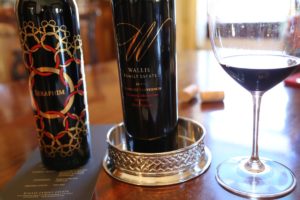 The 2011 Wallis Estate “little sister” take some time to open and breathe in order to reveal the fruit in the glass. But when it does, ultimately it develops a brighter bouquet than the prior vintage; the nose is elegant with attractive perfume notes and more red fruit (red licorice, red cherry) rather than dark as it breathes. The palate lingers with some baking spices and a fairly subtle note of vanilla. The tannins are fine-grained and linger softly, ultimately outlasting the fruit; they are felt more on the front of the palate rather than the back. This is a well-made wine in what was a difficult year for a number of vintners in the valley based on rain all the way into June, a cool summer and early rain during harvest. Based on the wines we have tried in the valley, this was a vintage in Napa Valley where in general, hillside vineyards fared best (13.5% alcohol).
The 2011 Wallis Estate “little sister” take some time to open and breathe in order to reveal the fruit in the glass. But when it does, ultimately it develops a brighter bouquet than the prior vintage; the nose is elegant with attractive perfume notes and more red fruit (red licorice, red cherry) rather than dark as it breathes. The palate lingers with some baking spices and a fairly subtle note of vanilla. The tannins are fine-grained and linger softly, ultimately outlasting the fruit; they are felt more on the front of the palate rather than the back. This is a well-made wine in what was a difficult year for a number of vintners in the valley based on rain all the way into June, a cool summer and early rain during harvest. Based on the wines we have tried in the valley, this was a vintage in Napa Valley where in general, hillside vineyards fared best (13.5% alcohol).
The 2010 Wallis Estate Cabernet Sauvignon like the other vintages is dark in the glass. It features notes of ripe blackberry, cedar and hints of brown chocolate on the bouquet. This wine exhibits a richness of flavor and bright acidity on the palate. Structurally, this is a robust wine yet still retains a pleasing balance. The finish shows dusty broad-based tannins which linger for quite some time.
A more recent addition to their portfolio is the Seraphim – a barrel select of their best barrels of Cabernet Sauvignon.
NOTE: this section of this review has been identified as needing a major update as additional wines are now being produced since our first visit with Edward, including from Denali Estate.
—
Wallis Estate generally produces in the range of 1,000 cases a year and are selectively distributed in premium wine shops and restaurants in about 25 states including California, Texas and Florida among others. Unlike most small producers who don’t keep much inventory of older vintages, Wallis Estate often has wines for sale dating back 10-15 years. For more information, to purchase wine, to join their mailing list or wine club, please visit: www.wallisestate.com

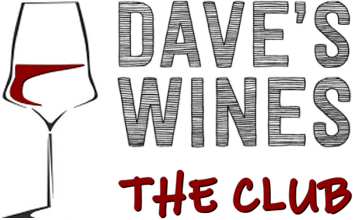




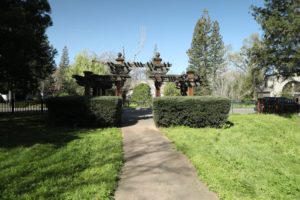
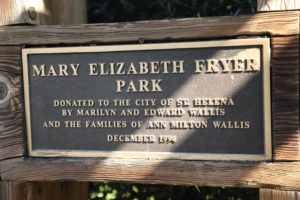
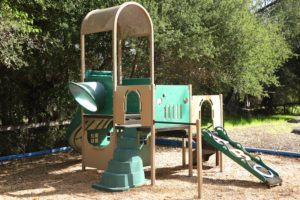
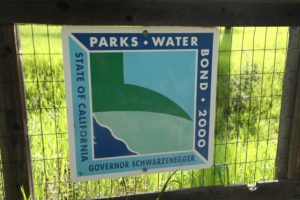
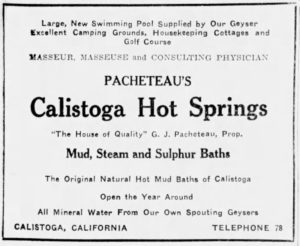
Hi Ed
While visiting Calistoga last weekend I remember the many visits
To your home (long time ago)
So glad to see you still living and enjoying your beautiful home, following your passion for wine.
💇 Francine Loutas
Francine – I hope you connected with Edward – his place on Diamond Mountain is gorgeous 🙂